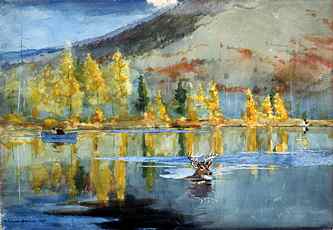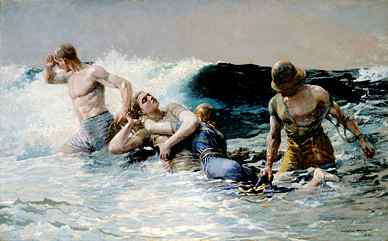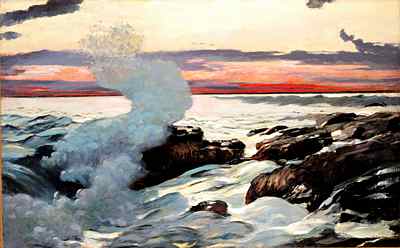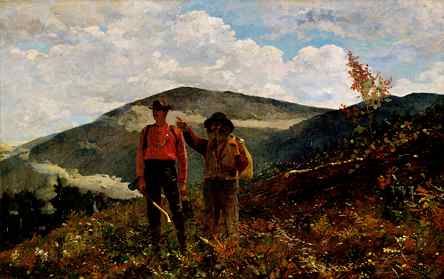
Editor's note: The Clark Art Institute provided source material to Resource Library for the following article or essay. If you have questions or comments regarding the source material, please contact the Clark Art Institute directly through either this phone number or web address:
Winslow Homer: Making Art, Making History
October 9, 2005 - January 16, 2006

(above: Winslow Homer, An October Day, 1889. The Sterling and Francine Clark Art Institute, Williamstown, Massachusetts)
The Sterling and Francine Clark Art Institute will present an innovative exhibition of Winslow Homer's (1836-1910) work this fall. In the largest showing from the Clark's extensive Homer holdings in decades, the exhibition offers insights into the artist's achievement, raises questions about the variable nature of history, and documents the collection's own institutional past.
On view from October 9, 2005, through January 16, 2006, Winslow Homer: Making Art, Making History will showcase 10 oil paintings, 11 watercolors, 17 drawings and etchings, and one photograph, as well as approximately 120 rarely seen wood engravings. Comprising almost 250 works by Homer, dating from 1857 to 1904, the Clark's deep holdings provide a variety of distinctive perspectives on this important American artist. The project continues the Clark's tradition of creating exhibitions -- such as those recently devoted to Jacques-Louis David, Gustav Klimt, and J.M.W. Turner -- that cast new light onto the careers of well-known artists.
"The Clark's unparalleled setting on 140 acres in a region where Homer lived and worked will enhance visitors' appreciation of the artists' work," said Michael Conforti, director of the Clark. "Homer's portrayals of the New England coast, mountains, outdoor recreation and rural life are a particularly appropriate celebration of the Clark's 50th anniversary and the resources -- natural and artistic -- that distinguish the institution."
Winslow Homer: Making Art, Making History will bring the full range of the Clark's Homer collection to the
public, including works on  paper
that are, due to their light-sensitive nature, only rarely on view. While
these many objects will encourage wonder at Homer's aesthetic achievement,
the breadth of the collection also allows questions to be asked about relations
among the things themselves, their place in the art world of the 19th century,
and the role they play in helping us understand their era. Questions of
history -- cultural, institutional, and biographical -- lie at the core
of the show's approach. (right: Winslow Homer, Undertow, 1886.
The Sterling and Francine Clark Art Institute, Williamstown, Massachusetts)
paper
that are, due to their light-sensitive nature, only rarely on view. While
these many objects will encourage wonder at Homer's aesthetic achievement,
the breadth of the collection also allows questions to be asked about relations
among the things themselves, their place in the art world of the 19th century,
and the role they play in helping us understand their era. Questions of
history -- cultural, institutional, and biographical -- lie at the core
of the show's approach. (right: Winslow Homer, Undertow, 1886.
The Sterling and Francine Clark Art Institute, Williamstown, Massachusetts)
"The scope of the Clark's collection and the range of media represented allow us to ask a number of intriguing questions of Homer's works," said Marc Simpson, curator of American art at the Clark and organizer of the exhibition. "Many of them began as documents -- of the Civil War, for example, or fashion -- then became the meat of art history, and are now frequently illustrations of economic, political, and social histories. The exhibition will tease out strands from just a few of these many different stories-along with the history of the Clark collection itself."
The oil paintings in the Clark collection are among Homer's finest. As a group, they offer insight into Homer's thematic and technical development over nearly his full career. Responses from across the hundred-plus years since their creation will reveal how perspectives on Homer's work have shifted. Among the best-known of the Clark paintings is Two Guides (1877), depicting two identifiable Adirondacks guides in the wilderness. When first shown in 1878, the work barely attracted critical notice, and some critics thought its handling "sketchy and slovenly." By 1898, it was judged to be "a vigorous bit of realism." And in 2005, it is one of the Clark's "50 Favorites." West Point, Prout's Neck (1900) shows an even more extreme example of changing attitudes. Homer, writing in 1901, thought it "the best thing I have painted." But one New York critic of the day called it, simply, the worst picture in that year's Society of American Artists exhibition. Since the mid-20th century, most art historians have come to see it -- as the artist thought -- as one of his greatest achievements.
Among the other major oil paintings featured is Undertow (1886). The Clark owns not only the painting but an unusual cache of six preparatory drawings for it, enabling visitors and scholars to take an intimate look at the artist's design process and offering insights into how Homer developed one of his largest and most singular works.
Winslow Homer: Making Art, Making History will include approximately 120 wood engravings. Designed by Homer for such periodicals as Harper's Weekly and Appleton's Journal, the wood engravings illustrate news of the day: the Civil War, the rise of various leisure activities, changing fashions, the shifting role of women in society. Their distinctive installation will underscore the engravings' origin as newspaper illustrations and will encourage visitors and scholars to explore them as sources of historical data. Elsewhere in the gallery, visitors will be able to track the engravings' transformation from ephemera to valued artworks.
Though rarely on public view, the Clark's watercolors by
Homer are among the most popular and appealing works in the collection.
The 11 watercolors cover nearly the whole span of Homer's career. The exhibition
will trace Homer's development, the collecting priorities of founder Sterling
Clark, and the rise of the status of watercolors in the American art world.
Highlights include the simple Lemon (1876), the glowing Adirondack
scene An October Day (1889), and Fish and Butterflies (1900).

A group of etchings, heliotypes, and chromolithographs by or after Homer reveal technologies the artist used to make his art more accessible to the collecting public. Among the high points of these is the etching Perils of the Sea (1887), which will hang beside the Clark's watercolor of the same subject from 1881. The exhibition will also feature some of Homer's illustrations of popular literature and poetry, including The Courtin' by James Russell Lowell (1874). Another "marketing strategy" that Homer developed was to work up drawings-generally seen as preparatory studies-into finished, saleable works. Two of these fully realized drawings, Fisher Girl with Net (1882) and Schooner at Anchor (1884), are included in the exhibition. (right: Winslow Homer, West Point, Prout's Neck, 1900. The Sterling and Francine Clark Art Institute, Williamstown, Massachusetts)
Simpson organized the exhibition with the assistance of Susannah Maurer, a student in the Clark/Williams College Graduate Program in the History of Art. The two-year masters degree program, housed in the Clark's important research library, is the leading program of its kind in the United States.
About Winslow Homer
Winslow Homer (1836-1910), was born in Boston, grew up in nearby Cambridge, Massachusetts. Mostly self-taught, Homer's early career included employment as an apprentice for a lithographic firm in Boston and as an illustrator for Harper's Weekly , in New York, chronicling the Civil War. After trips abroad to Paris and England, in 1884 he settled in Prout's Neck, Maine, where he lived for the remainder of his life. That site, along with his various North American travels -- which ranged from the Bahamas to Canada, with a special focus on the Adirondacks in New York -- fueled his later art.
"50 Favorites"
Three works by Homer have been selected for "50 Favorites," a special presentation of works from the Clark's collection in celebration of the Clark's 50th anniversary. The Clark invited people to vote for their favorite works, and 50 of them will be on view from May 17, 2005 - May 17, 2006. Sleigh Ride, Two Guides, and West Point, Prout's Neck will be on view.
About the Clark
Beginning in May 2005, the Clark will celebrate its 50th anniversary with a year-long program of special exhibitions and initiatives, including the establishment of a new prize for arts writing and the first national tour of masterpieces from its permanent collection. The program also encompasses several special exhibitions including Jacques-Louis David: Empire to Exile (June 5 to September 5, 2005), the first exhibition to examine the artist's post-Revolutionary years; Little Women, Little Men: Folk Art Portraits of Children from the Fenimore Art Museum (July 4-October 9, 2005) featuring 11 paintings of children by American itinerant portrait artists including Ammi Phillips, Erastus Salisbury Field, Joseph Whiting Stock, William Matthew Prior, and others (part of the Berkshire-wide collaboration "American Traditions"). In summer 2006, The Clark Brothers Collect Renoir to Matisse, Homer to Hopper will explore the collecting history of Sterling Clark and his brother Stephen, bringing together works from their acclaimed collections for the first time. Celebrations and programs are planned for area residents throughout the 18-month festivities.

(above:Winslow Homer, Two Guides,1877. The Sterling and Francine Clark Art Institute, Williamstown, Massachusetts)
Editor's note: RL readers may also enjoy these earlier articles and essays:
and these videos:

Winslow Homer: An American Original is a 49 minute 1999 HBO Artists' Specials series program directed by Graeme Lynch and produced by Devine Entertainment. The artist Winslow Homer has become famous for his illustrations of battle scenes during the Civil War, but he feels disenchanted with what he has experienced and withdraws to a quiet farm. There he meets a pair of teenagers whose lives have been shaken by the war. Together, Homer and the kids learn from each other and move forward with life.

Winslow Homer: The Nature of the Artist is a 29 minute 1986 video directed by Steve York from the National Gallery of Art Series. The art of Winslow Homer is examined in this profile of the American artist, from his early illustrations of the Civil War and his picturesque scenes of the country and shore, to the powerful images of nature that characterize his mature and late work. Commentary by the American art historian John Wilmerding provides a guide to Homer's artistic progress and to his achievements, particularly his transformation of the watercolor medium from the purely descriptive into a highly expressive vehicle.
and these resources on the Web for Winslow Homer:
rev. 6/10/05
Links to sources of information outside of our web site are provided only as referrals for your further consideration. Please use due diligence in judging the quality of information contained in these and all other web sites. Information from linked sources may be inaccurate or out of date. Traditional Fine Arts Organization, Inc. (TFAO) neither recommends or endorses these referenced organizations. Although TFAO includes links to other web sites, it takes no responsibility for the content or information contained on those other sites, nor exerts any editorial or other control over them. For more information on evaluating web pages see TFAO's General Resources section in Online Resources for Collectors and Students of Art History.
Read more articles and essays concerning this institutional source by visiting the sub-index page for the Clark (Sterling and Francine) Art Institute in Resource Library.
Visit the Table of Contents for Resource Library for thousands of articles and essays on American art.
© Copyright 2005 Traditional Fine Arts Organization, Inc., an Arizona nonprofit corporation. All rights reserved.